
ARCHIVE
Pesakh 5770 - 2010
Erev Purim 5770 (February 27, 2010) at Ohel Hachidusch
Anja´s Wimpel presentation at our Torah Celebration
Workshop with Rabbi Shefa Gold: Path of Love on November 6th -8th, 2009
Sukkot 2009
3rd of July 2009: Rabbi Eveline Goodman-Thau celebrates Kabbalat Schabbat with Ohel Hachidusch
Pessach 2009
Opening the Heart, April 4-6, 2008
2. International Ohel Hachidusch Congress
Program Shabbat Behalotecha June 1-3 2007 in Oslo
Greeting by Elisa Klapheck
Program of the first international Ohel Hachidusch-Congress in Berlin
Pesakh 5770 - 2010
Many old and new friends joined the Ohel family on Pesakh Seder, the
very special get-together of family and friends. Some of our friends
came from far away. As in previous years Anna opened her spacious
studio for us.
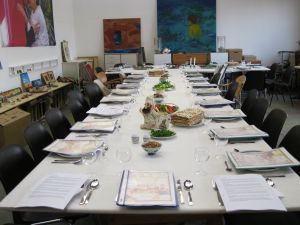

Together we cleaned and prepared the room to have enough space for our
big Pesakh table but still it was pleasantly crowdy and we had to add
another table.
Our Cantor Jalda lead us skilfully as always and with lots of joy,
engagement and many songs through the Haggadah. We felt the stifling
tightness of Mitzrayim and moved into freedom. Hallelujah!
Our Seder dinner surpassed all expectations. Anna and her cooking team
put a lot of time and passion into the menu.The two experts Anna and
Sabrina cooked together. And many helping hands joined in cleaning up,
just as one would expect it to happen in a good family.
Thanks to Jalda, Anna, Sabrina and all helpers!
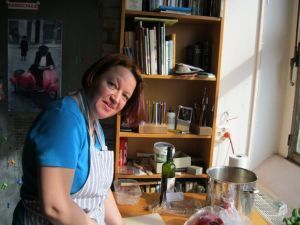

Let us cite two of our guests from the United States:
Sabrina comments in her blog:
"The Seder may have beeen conducted in German and it may not have
included any of my relatives, but afer the 5th glass of wine it felt
exactly like the Seders of my childhood".
You will find the complete blog with many photos and Anna´s
and
Sabrina´s delicious Seder recipes under
http://www.foodandfootage.com/.
Special thanks go to Nalini for the photos on this page. She summarizes
her feelings about our Seder:
"Being part of the Pesakh celebration at Ohel Hachidusch was a blessed
highlight of my year. The kahal is welcoming and warm and Jalda's
hosting made for a rich experience opening me to be able to taste a
real bit of freedom yet again. The food was exceptional as well.- thank
you to Anna and Sabrina. I can't wait to return!" -- Nalini Indorf
Kaplan

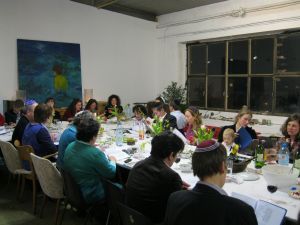
_____________________________________________________________________________
Erev
Purim 5770 (February 27, 2010) at Ohel
Hachidusch


Every year we pass through different festivals with
varying contents in order to bring us into different moods according to
the choreography of the Jewish calendar. In February it was
time
again to celebrate a proper Purim-party at Ohel ha-Chiddusch. What is a
proper Purim festival like? It consists of communal prayer, reading the
legend of Esther and Mordechai, contemplating together the miraculous
salvation of the Jews; and last but not least it is … having
a
delicious meal and good drink. All this we have done extensively in our
tent.
During Purim Judaism shows it’s most expressive and wildest
customs. But at the same time the story of Esther poses a lot to think
about. If there is an emotive word in the Jewish tradition - it is
Amalek. Why is it like this? When the Israelites where attacked and
beaten by the Canaanites during their passage through the desert, who
excelled at the butchery? Amalek. Due to whom the career of King Saul
came to a sudden end? Amalek. And whom did the Jews reencounter in the
great Persian Empire in the person of a court officer? Haman was a
descendant of Amalek. But there is a comforting difference in the story
of Esther compared to the reports of other wars and victories. One
woman only, herself without rights, acts and turns the tide,
according to which the termination of her community seemed to be
already decided. At the end Haman himself suffered the fate he intended
to impose on the Jewish people of Persia. But the story does not answer
the question why also his sons had to share the same destiny with him.
If understandable at all, than may be in a symbolic way; it could be
the attempt to supersede evil now and for ever, personified by Amalek.
But this evening we have concentrated more on
turning the
festival into a funny event for the whole family. To Ohel ha-Chiddusch
this means that not only the children appear fancifully camouflaged but
the adults too. And it is also an obligation of honour for us to listen
attentively to the reading of the Purim story, for nobody wants to miss
only one moment of rattling and yelling down every name-dropping of
Haman in an outburst of noise. Also in the Purim story as reshaped by
Jona (Kirchner) there were more than enough opportunities to do so. It
is beginning like this: „Once upon a time in a galaxy far,
far
away and long, long time ago … between two spiral arms of
this
galaxy, at position 30°MZPerX12’5 there was a little
area in
space, where usually nothing happened most of the time, there was a
solar system with 8 planets. At the third planet a Kingdom was situated
ruling over 127 colonies spread out over the whole solar system. The
name of the empire was Paras u-Madai, and its capital was Schuschan.
…“ At the first glance the original story may not
recognisable anymore…, but it concludes with the familiar
result: The people of Jehuda still have a future, and will have it
again and again. In this way we have diligently fulfilled the
instruction of the Torah to all Jewish communities: for ever to
remember to forget about Amalek.
Original text and translation by Jona Kirchner
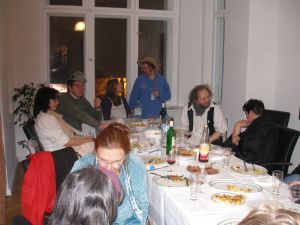

_____________________________________________________________________________
Anja´s speech when presenting the Wimpel to Reb Arnie for the Blumenstein-Family Torah:
Dear guests, dear guests from
Shir Tikvah,
a genuine Jewish invention of the 16 th Century. The Wimpel is made
out of the
swaddling cloth that was used
during the Brit Mila. It is then embroidered or painted and the name of
the boy
is written on it . When
the boy is three
years old and he accompanies his father to Shul for the first time, he
hands
over his Wimpel to the community and the Torah is then wrapped with the
Wimpel
of this particular boy. Until the next boy brings his and then again
another
boy comes. The Wimpels that are not used anymore are kept in the Beit
Knesset
and serve as a family history book of the members of the community.
The women of Ohel HaChidusch
took pleasure in embroidering a Wimpel
for the new Torah of the Shir Tikvah Community and hope that this is
understood
as a sign of the bond between our groups.
Thank you for donating to us this several centuries old Torah Scroll .
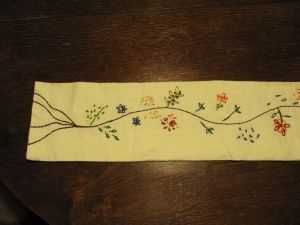
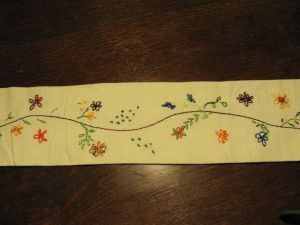

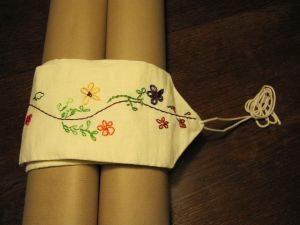
All women of
Ohel Hachidusch embroidered at least one flower of the Wimpels for the
Blumenstein-Family Torah and our own Beth Jacob Torah.
Nov.6th to 8th 2009: Workshop with Rabbi Shefa Gold: Path of Love
We enjoyed the great privilege to experience Rabbi Shefa Gold from Jemez Spring, New Mexico, USA in a workshop here in Berlin. She is one of the leading personalities of Aleph – the Alliance for Jewish Renewal- and following the invitation of Ohel Hachidusch e.V. she came to Germany for the first time. She received her ordination from Reconstructionist Rabbinical College and Rabbi Zalman Schachter-Shalomi. Her compositions and liturgies found their way into modern Siddurim. Rabbi Gold trains Rabbis, Cantors and lay leaders in the context of Kol Zimra, a special two-year program. She works with the Institute for Jewish Spirituality in New York The energy and inspiration for her work she not only draws from her Jewish roots but also from Buddhist, Christian and Islamic traditions as well as from spiritual strands of native Indian culture. She creates connections, where these traditions meet one another at the access to the one source of love.
Channah summarized the particularity of this workshop as follows:
„Path of Love, which was conceptualized and realized by Rabbi Shefa Gold, is a sensitive and professional instruction for the meaningful, quiet approach to the nurturing sources of our Jewish texts. Path of Love also means to discover oneself and one’s abilities to create a community.
Structured as a Shabaton Shefa Gold lead us by means of teachings and chants far into Hawdala in the course of a unique Shabbat.
We know these texts from Siddur and Tenach, Rabbi Shefa Gold however offers us an entirely new insight into the depth and beauty of these words through her teachings. By chanting together we experience and come in contact with the force hidden in these words. In the ensuing silence we have space and time to absorb reconciliation, healing, growth and the reanimation of tenderness.
We encounter the texts with attentive minds and open hearts. Under the guidance of Rabbi Shefa Gold we learn fast and almost without noticing to be loving and caring.
Quietly yet clearly perceptible a communion is growing. We celebrate Shabbat.
At the end she poses the question: in which way do you want to take something of what you have learned into your daily life and commit yourself to living accordingly?
Path of love is a way of living.“
(Translated by Ruth and Daniel).


Rabbi Shefa Gold (right) in her workshop "Path of Love"
______________________________________________________________________________________________
Sukkot 2009
Erev Sukkot on 15th of Tischri 5770 -this year also Erev Schabbat- Anja-Riwka and her family invited us to build our sukka in their garden. As in previous years we constructed our sukka under the expert guidance of Anna. It took us 2 days but in the end our sukka was a beauty and we had lots of fun building it.Luckily we managed to finish it just before the weather drastically changed. After lighting the candles and after celebrating kiddush we were dancing and singing for a while in our temporary shelter while rain drops poured through the airy roof. Then our hosts invited us into their warm living-room to continue our celebration of shabbos and sukkot without catching a cold.The Ohel(tent)-inhabitants surpassed themselves with all the tasty creations on a festive table. It was a very successful sukkot and Schabbat celebration and our sincere thanks are given to our hosts.
Marlis V.
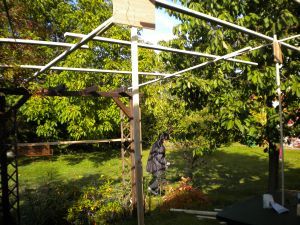

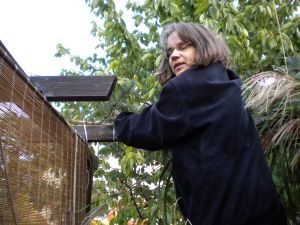
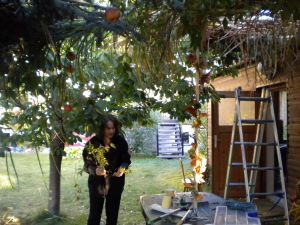

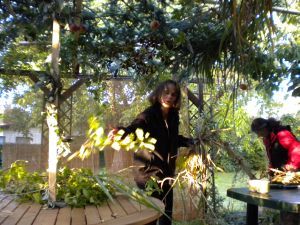
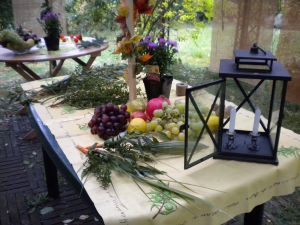
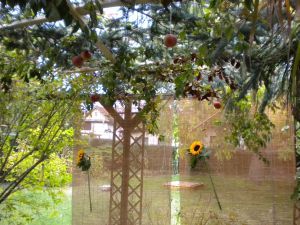
______________________________________________________________________________
Pessach 2009
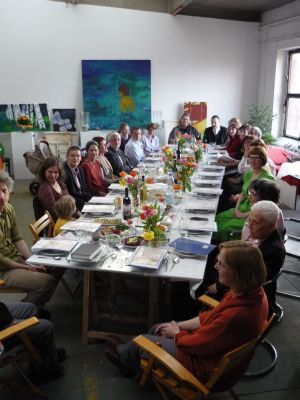
2nd seder evening on 15th of April 2009/ 9th of Nissan 5769
we celebrated in Anna´s studio. Chasan Jalda lead us through the Hagadah
and showed us the road out of our personal mizrajim. Benny (3) found the
afikomen so we could finish the seder ceremony.
Many thanks to all who arranged this seder with so much joy and heart.
We were 30 persons sitting cosily crowded at our beautifully decorated
seder table, - united in Jewish traditions of many centuries.
___________________________________________________________________________
JULY 3, 2009: Rabbi Goodman-Thau in Berlin:
Kabbalat Schabbat Chulat Balak we had a special guest: the unorthodox orthodox Rabbi Eveline Goodman-Thau welcomed with us the bride Schabbat. Rabbi Goodman-Thau surprised us with a fascinating d´var Torah and we in turn surprised her with our Ohel dainties for Kiddush which she -being an expert cook- enjoyed very much. Since on that occasion we also celebrated Rabbi Goodman-Thau´s birthday we naturally had some gifts for her but also Ohel Hachidusch received a present: a handmade Shabbos challah cover from Jerusalem! Until late in the summer evening we sat together singing and telling stories. Rabbi Goodman-Thau is looking forward to our next meeting in the tent (ohel) and we hope to welcome her again soon.
Best wishes to you, dear Rabbi Goodman-Thau and thank you for your inspiring visit!

2. International Ohel Hachidusch Congress
28.08.2008- 31.08.2008 in Lund / Sweden
Special Guests:
Rabbi Shawn Zevit (Philadelphia)
Rabbi Elisa Klapheck (Amsterdam/Frankfurt/Main)
Prof Roger Sages (Lund)
Aleph Rabbinical Senior Student Lynn Feinberg (Oslo)
Sonja Guentner (Köln) u.a.
Download REGISTRATION FORM 2008
further information here: CONGRESS
Opening the Heart:
Mindfulness Meditation and Jewish Practices for Inner Liberation
The Inner Journey of Passover Friday 6 p.m.-Sunday 2 p.m. April 4-6, 2008 Quelle des Mitgefühls, Heidenheimerstr. 27, 13467 Berlin-Hermsdorf
In this weekend retreat we will renew ourselves
through slowing down, silence, singing, sitting and walking meditation,
and many Jewish practices including preparing for Passover, Shabbat,
daily blessings, prayer and study. We will discover and practice
preparations for Passover that offer roadmaps for finding spiritual
connection and freedom from fears, anxiety and hopelessness.
Retreat Information and Registration: channah@freenet.de
Comfortable accommodations and nutritious vegetarian meals are served.
Roberta Wall was a founding member of the residential community at the
Elat Chayyim Jewish Retreat Center in New York State. She is a student
of Thich Nhat Hanh and has led Jewish practice at Plum Village. She
leads mindfulness and Jewish retreats and lives in the U.S.
www.steps2peace.com
Shabbat Behalotecha (In your lighting of the menorah)
The Womens Shabaton of June 1-3 2007 in Oslo, Norway.
If you are interested in joining please send an email to: lynn.claire@gmail.com
PROGRAMM
Friday June 1st.
17.00-19.00 Arrival
19.00 Welcome and orientation
19:30 Shirey be erev Shabat; introduction to some of the melodies used for Shabbat evening service led by Hazzan Jalda Rebling
20.20 We light the shabatcandles (Shabbat begins), followed by Kabbalet Shabbat, the service where we welcome Shabbat.
Kiddush, blessing of wine and Shabbat followed by dinner
Birkat ha mason/Benshen - we give thanks for the food
Saturday June 2.
9:30 Breakfast
10:30-13.00 Shacharit, morning service with torareading, dvar Torah etc.
Behalotecha is about spiritual leadership and what it entails. This is also a story about what happens to our people after having received Torah on Sinai, how fast they forget Sinai and the deeply reaching experiences they had there and how they let old habits and thought patterns get the upper hand. This is the week we also read about Miriam who gets tzaarat (an illness that makes her skin turn white) after she and Aharon rebuke Moshe. How can we understand these stories? Can they be of meaning for our lives today?
13.30 kiddush and lunch
During the meal we will continue to talk about what the service and Tora reading brought up.
Birkat ha mason
about 15.00 after lunch; time for a walk, talk, study in small groups, sleep etc.
ca 19.00 Mincha - a short service with torareading from portion of the week that follows, Shelach lecha, the portion about the scouts that are sent in to the promised land.
Ca. 20.30 Seudat Shlishit - the third meal.
Shabbat afternoon, the last hours of Shabbat..
The kabbalists tell us that the gates of heaven are wide open these last few hours before shabbat ends. Heavenly light and might is abundant. If we allow ourselves to open and receive this light our batteries are replenished for the week to come. It is a hassidic tradition to sing niggunim (songs without words) and tell stories around the meal table at this time. So this is what we also will do. Do you have a story, a song or melody with a Jewish content that you want to share? We will continue as long as we feel like. Officially Shabbat goes our at 01.15 in Norway, if we last that long we will do havdalah before going to bed, if not - we will do it the next morning.
Sunday June 3rd
10:30 Breakfast with wrap up and closure
Tidying up before departure around 12.00
We will use the services as a framework from where we can experience a deepening in relation to our tradition, texts and. You will also be given the opportunity to experience the function that Torah and the Toraservice has in a direct way.
Suggestions about what to bring:
- A shawl or Tallit
- Shabbat clothes, light/white or colourful clothes for Shabbat evening
- Shoes for inn and outdoors
- Clothes you might need for walking in the woods - it might rain
- Towels
- Sleeping bag /bedclothes (there are only mattresses, not blankets or duvets)
- Toiletry
- Extra money for wine to drink with the food (kosher)
- Siddur - (there will be made siddurim for the occation, but if you would like to cross reference with your own bring it along.)
- Chumash/Tanach - (there will also be copies made of the parasha)
Welcome and blessings from
Lynn and Jalda
Hazzan Jalda Rebling is ordained as chazzan (kantor) through Aleph Jewish Renewal. With her many years of experience as a Jewish storyteller, singer and actress and a teacher of Jewish culture she has a wide knowledge from which she can share and make Judaism come alive. During the last years she has been responsible for training two minjanim (prayer groups) in Germany where she lives. She is the main responsible person in forming a the European Jewish Network, Ohel Hachidusch; www.ohel-hachidusch.org an organisation from where to teach, develop and express Judaism and Jewish culture for all those who due to different reasons do not feel at home in traditional communities or for those who seek Jewish experiences and learning beyond what the traditional communities are able to offer. She will soon begin a training course in davvening (jewish prayer) leadership in Europe.
Chief responsible for this weekend is Lynn Claire Feinberg from Oslo, a rabbinical student under Aleph Jewish Renewal. As a part of this education she had participated in a two year program in davvening leadership and has a certificate as an Eco-kosher Masgiach (overseer of kosher). She is an Historian of Religion having specialized in Women and Judaism and is also trained as an Astrologer. She teaches a variety of Jewish themes and is presently engaged in creating texts and material to be used at the Jewish Museum in Oslo as it is being established. As a specialization within the rabbinical program she is training to become a mashpiah - a Spiritual Director.
Aleph Jewish Renewal in USA is a movement that aims at bridging all Jewish paths and denominations and to promote Judaism as living tradition and tool for inner growth and social action in the 21 century. As Jews we are facing changes that are as vast as the ones that happened after the fall of the 2.temple and the rise of rabbinical Judaism 2000 years ago. An important part of the renewal of today is women having more visible roles as spiritual leaders and creators of ritual space. Since the circumstances of Jews living in Europe are different than in the USA, Ohel Hachidusch has been created as a vehicle for this kind of change in Europe.
Dear Jalda, dear Marcia, dear Jack,
Dear Gesa, dear Avitall, dear Lynn,
Dear friends, and all other participants in the first Ohel Ha'Chidusch conference,
The first international Ohel Hachidusch-Congress in Berlin,
located at: Stiftung Neue Synagoge Berlin - Centrum Judaicum
May 10th - May 13th

Program:
Thursday, 10th of May, 2007
Arrival of participants at Stiftung Neue Synagoge Berlin
7.30 p.m.: Opening in Celebration Hall, Centrum Judaicum
- Lecture by Rabbi Marcia Prager
- Music by Chasan Jalda Rebling and Chasan Jack Kessler
Friday, 11th of May, 2007
Lectures with following discussions about:
10.00 a.m.-12.30: Visions for renewal of Jewish tradition in Europe
02.00 p.m.-03.45 p.m. Several workshops: Singing, Talmud-Studying, Social work etc.
- Prof. Tal Ilan: Masekhet Bavli Ta´anit als Beispiel für einen feministischen
Kommentar des Babylonischen Talmud
- Lynn Feinberg: Eco-Kashrut - A New Kind of Kosher?
- Lilith Schlesinger: Women und Tallit
- Sandra Lustig: Turning the Kaleidoscope -
Perspectives on European Jewry
- Joav Yoga

04.00 p.m.-5.30 p.m.
- Rabbi Marcia Prager: The Four Worlds of Jewish Renewal (1)
- Chasan Jack Kessler: The Spiritual Power of Nussach:
the Synagoge Chant Tradition (1)
8:00 p.m. Lichteranzünden and Kabbalat Schabbat
Rabbi Marcia Prager, Chasan Jack Kessler, Chasan Jalda Rebling
Saturday, 12th of May, 2007
10:00 a.m. - 1:00 p.m. Schacharit Schabbat, following Kiddusch
Rabbi Marcia Prager, Rabbi Gesa Ederberg, Chasan Jack Kessler,
Kantorin Avital Gerstetter, Chasan Jalda Rebling

04:00 p.m. - 05:30 p.m. Workshops:
- Rabbi Marcia Prager The Four Worlds of Jewish Renewal (2)
- Chasan Jack Kessler: The Spiritual Power of Nussach:
the Synagoge Chant Tradition (2)
06:00 p.m. - 07:00 p.m. Schabbat Mincha
09:00 p.m. - 09:30 p.m. Ma´ariw Chasan Jack Kessler, Chasan Jalda Rebling
10:05 p.m. Hawdala and public concert in Celebration Hall, Centrum Judaicum
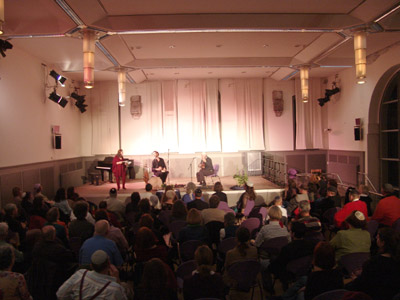

Sunday, 13th of May, 2007
11.00 a.m. - 02.00 p.m. final session Rabbi Marcia Prager, Chasan Jalda Rebling
11.30 a.m. - 01.00 p.m. Presentation of the results and final discussion in plenum
03.30 p.m. Guided walking tour through Berlin-Mitte with Milk & Honey-Tours
Speakers:
Rabbi Marcia Prager, Philadelphia, USA
Chasan Jack Kessler, Philadelphia, USA
Lynn Feinberg, Oslo, Norwegen
Prof. Tal Ilan, Berlin, Freie Universität Berlin
Rabbi Gesa Ederberg, Berlin
Chasan Jalda Rebling, Berlin
Cantor Avital Gerstetter, Berlin
Lilith Schlesinger-Baader, Berlin
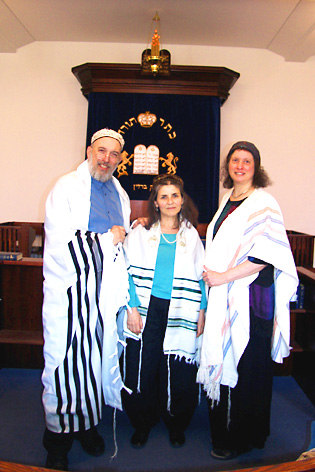
Chasan Jack Kessler, Chasan Jalda Rebling, Rabbinerin Marcia Prager
in cooperation with:





and kindly supported by:

Friedrich-Ebert-Stiftung, Berlin
and by the Council of the Berlin Borough of Pankow